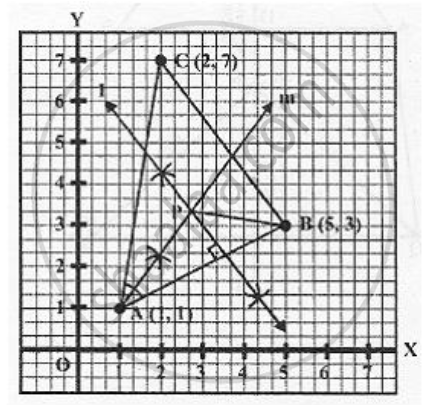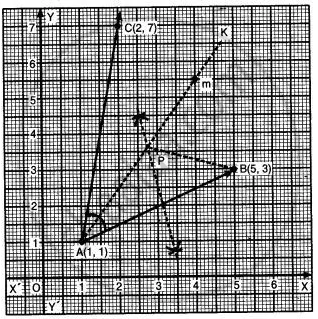Advertisements
Advertisements
Question
Use graph paper for this question. Take 2 cm = 1 unit on both the axes.
- Plot the points A(1, 1), B(5, 3) and C(2, 7).
- Construct the locus of points equidistant from A and B.
- Construct the locus of points equidistant from AB and AC.
- Locate the point P such that PA = PB and P is equidistant from AB and AC.
- Measure and record the length PA in cm.
Solution 1

Steps of Construction:
- Plot the points A(1, 1), B(5, 3) and C(2, 7) on the graph and join AB, BC and CA
- Now we should join points A and B. Draw perpendicular bisector l of AB. Then, l is the locus of points which are equidistant from A and B.
- Now we should join A and C. Also draw the angle bisector m of ∠CAB. Then, m is the locus of points equidistant from AB and AC.
- Draw the perpendicular bisector of AB and angle bisector of angle A which intersect each other at P. P is the required point. Since P lies on the perpendicular bisector of AB. Therefore, P is equidistant from A and B.
Again,
Since P lies on the angle bisector of angle A.
Therefore, P is equidistant from AB and AC. - On measuring, the length of PA = 2.5 cm
Solution 2

- Plot the points A(1, 1), B(5, 3) and C(2, 7) as shown.
- Join points A and B. Draw right bisector l of AB. Then, l is the locus of points equidistant from A and B.
- Join A and C. Now draw the bisector m of ∠CAB. Then, m is the locus of points equidistant from AB and AC.
- The point of intersection P of right bisector of AB and angle bisector of ∠CAB is the point such that PA = PB and P is equidistant from AB and AC.
- On measuring PA = 2.5 cm.
RELATED QUESTIONS
Draw an angle ABC = 75°. Find a point P such that P is at a distance of 2 cm from AB and 1.5 cm from BC.
Ruler and compasses may be used in this question. All construction lines and arcs must be clearly shown and be of sufficient length and clarity to permit assessment.
- Construct a ΔABC, in which BC = 6 cm, AB = 9 cm and angle ABC = 60°.
- Construct the locus of all points inside triangle ABC, which are equidistant from B and C.
- Construct the locus of the vertices of the triangles with BC as base and which are equal in area to triangle ABC.
- Mark the point Q, in your construction, which would make ΔQBC equal in area to ΔABC, and isosceles.
- Measure and record the length of CQ.
Construct an isosceles triangle ABC such that AB = 6 cm, BC = AC = 4 cm. Bisect ∠C internally and mark a point P on this bisector such that CP = 5 cm. Find the points Q and R which are 5 cm from P and also 5 cm from the line AB.
AB and CD are two intersecting lines. Find a point equidistant from AB and CD, and also at a distance of 1.8 cm from another given line EF.
Without using set squares or protractor, construct a quadrilateral ABCD in which ∠ BAD = 45° , AD = AB = 6 cm, BC= 3.6 cm and CD=5 cm. Locate the point P on BD which is equidistant from BC and CD.
Construct a rhombus ABCD whose diagonals AC and BD are 8 cm and 6 cm respectively. Find by construction a point P equidistant from AB and AD and also from C and D.
In Δ PQR, s is a point on PR such that ∠ PQS = ∠ RQS . Prove thats is equidistant from PQ and QR.
Draw and describe the lorus in the following cases:
The locus of points at a distance of 4 cm from a fixed line.
Describe completely the locus of points in the following cases:
Point in a plane equidistant from a given line.
Construct a triangle ABC, such that AB= 6 cm, BC= 7.3 cm and CA= 5.2 cm. Locate a point which is equidistant from A, B and C.
